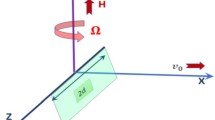Abstract
Multi-dimensional heat transfers modeling is crucial for building simulations of insulated buildings, which are widely used and have multi-dimensional heat transfers characteristics. For this work, state-model-reduction techniques were used to develop a reduced low-order model of multi-dimensional heat transfers. With hot box experiment of hollow block wall, heat flow relative errors between experiment and low-order model predication were less than 8% and the largest errors were less than 3%. Also, frequency responses of five typical walls, each with different thermal masses or insulation modes, the low-order model and the complete model showed that the low-order model results agree very well in the lower excitation frequency band with deviations appearing only at high frequency. Furthermore, low-order model was used on intersection thermal bridge of a floor slab and exterior wall. Results show that errors between the two models are very small. This low-order model could be coupled with most existing simulation software for different thermal mass envelope analyses to make up for differences between the multi-dimensional and one-dimensional models, simultaneously simplifying simulation calculations.
Similar content being viewed by others
References
Building energy efficiency research center of Tsinghua university. 2012 Annual report on China building energy efficiency [M]. Beijing: China Architecture & Building press, 2012: 2–4. (in Chinese)
LIU Ming, CHEN Bin, FAN Yue, ZHU Jia-yin, SUO Jian. Design of low-energy building and energy consumption analyses [J]. Journal of Central South University of Technology, 2009, 16(s1): 239–243.
DBJ 01-602-97. Energy conservation design standard for new heating residential buildings detailed rules for application in Beijing area [S]. ( in Chinese)
DBJ 11-602-2006. Design standard for energy efficiency of residential buildings [S]. (in Chinese)
DB11/891-2012. Design standard for energy efficiency of residential buildings (solicit opinions manuscript) [S]. (in Chinese)
ZHOU Long, BAI Min-li, LÜ Ji-zu, CUI Wen-zheng. Theoretical solution of transient heat conduction problem in one-dimensional double-layer composite medium [J]. Journal of Central South University of Technology, 2010, 17(6): 1403–1408.
XIAO Yi-min, LIU Xi-chen, ZHANG Rong-rong. Calculation of transient heat transfer through the envelope of an underground cavern using Z-transfer coefficient method [J]. Energy and Buildings, 2012, 48(5): 190–198.
Energy plus simulation software [R]. Berkeley: Ernest Orlando Lawrence Berkeley National Laboratory, 2011.
TRNSYS 17. 0. A transient system simulation program [R]. Madison: Solar Energy Laboratory University of Wisconsin, 2010.
DA Yan, XIA Jian-jun, TANG Wai-yin, SONG Fang-ting, ZHANG Xiao-liang, JIANG Yi. DeST-An integrated building simulation toolkit Part I: Fundamentals [J]. Building Simulation, 2008, 1(2): 95–110.
MARTIN K, ERKOREKA A, FLORES I, ODRIZOLA M, SALA J M. Problems in the calculation of thermal bridges in dynamic conditions [J]. Energy and Buildings, 2011, 43(2/3): 529–535.
THERM. A PC program for analyzing the two-dimensional heat transfer through building products [R]. University of Illinois/Ernest Orlando Lawrence Berkeley National Laboratory, 2011.
HEAT3. PC-program for heat transfer in three dimensions-Manual with brief theory and examples [R]. Lund: Lund-Gothenburg Group for Computational Building Physics, 2010.
JIANG Yao-lin. Model order reduction methods [M]. Beijing: Science Press, 2010: 5–8. (in Chinese)
ZHAO Hong-shan, SONG Guo-wei, JIANG Quan-yuan. Reduction of power system model using balanced realization method [J]. Transactions of China Electrotechnical Society, 2010, 25(2): 127–133. (in Chinese)
WANG Kai, WU Fan, JIANG Chang-sheng. Balanced proper orthogonal decomposition and its application in order reduction of aeroelastic models of aircraft wing [J]. Journal of Vibration and Shock, 2012, 31(9): 69–72. (in Chinese)
WANG Zhong-xia, LIU Lei, XU Yu, XU Jian-zhong. Reduced order models for the aerodynamic calculation of the wind turbine airfoil [J]. Journal of engineering therrmophysics, 2011, 32(9): 1489–1492. (in Chinese)
REIS T, STYTEL T. Balanced truncation model reduction of second-order systems [J]. Mathematical and Computer Modelling of Dynamical Systems, 2008, 14(5): 391–406.
EN ISO 8990. Thermal insulation: Determination of steady-state thermal transmission properties, calibrated and guarded hot box [S].
EN ISO 6946. Building components and building elements: Thermal resistance and thermal transmittance, Calculation method [S].
GEBHART B, JALURIA Y, MAHAJAN R L, SAMMAKIA B. Buyancy-induced flows and transport [M]. New York, NY, USA: Hemisphere Publishing Co, 1988: 749–750.
Author information
Authors and Affiliations
Corresponding author
Additional information
Foundation item: Project(51178023) supported by the National Natural Science Foundation of China
Rights and permissions
About this article
Cite this article
Gao, Y., Fan, R., Zhang, Ql. et al. Building dynamic thermal simulation of low-order multi-dimensional heat transfer. J. Cent. South Univ. 21, 293–302 (2014). https://doi.org/10.1007/s11771-014-1940-5
Received:
Accepted:
Published:
Issue Date:
DOI: https://doi.org/10.1007/s11771-014-1940-5




